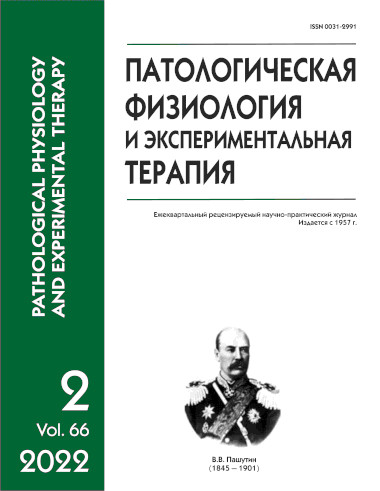Effect of antibodies to glutamate on caspase-3 activity in brain structures of mice with age-related memory changes
Abstract
The aim of the study was to investigate the effect of antibodies to glutamate (AT-GL) on caspase-3 activity in hippocampal and prefrontal cortex structures in C57Bl/6 mice with age-related memory change. Methods. Experiments were performed on 30 male C57Bl/6 mice (mean weight 31.2±1.7 g) at the age of 12 months. The animals were divided into 2 groups. The experimental group of mice (n=20) received purified antibodies to glutamate (250 µg/kg, 4 µl) dissolved in saline intranasally into each nostril for 14 days. Control animals (n=10) were similarly injected daily intranasally with 4 μl of physiological solution for 14 days. Twenty-four hours after the final administration of the solutions, animals from both groups were evaluated in the passive avoidance reflex test (PSRT) according to the standard technique. One part of the animals was decapitated immediately after the end of the behavioral experiment, the other part 7 days after withdrawal of AT-GL administration. After brain extraction at −4°C, the hippocampus and prefrontal cortex were isolated, and the material was preserved at −85°C. Caspase-3 activity was detected by incubating aliquots of supernatant at 37°C in the presence of incubation buffer containing the caspase-3 substrate acetyl-asp-gluval-asp-p-nitroanilide. The release of p-nitroaniline into the reaction mixture was assessed after 30 min spectrophotometrically at 405 nm. The activity of caspase-3 was calculated by the rate of p-nitroaniline release in nmol/min per 1 mg of protein and expressed as a percentage, taking the activity of the enzyme in control animals as 100%. To confirm the specificity of acetyl-asp-gluval-asp-p-nitroanilide hydrolysis by caspase-3, experimental samples were additionally incubated in the presence of the caspase-3 inhibitor Ac-DEVD-CHO. As negative controls, aliquots of supernatants without added caspase substrate were incubated separately. Results. Behavioral experiments revealed an improvement in the production of the PSRT on day 15 from the start of intranasal administration of AT-GL. As a result of neurochemical study of the brain structures, an increase in caspase-3 activation in the prefrontal cortex was observed in mice after 14 days of intranasal administration, and 7 days after the abolition of antibodies, the activity of caspase-3 did not differ from its activity in the control group of animals. No changes in caspase-3 activity were detected in the hippocampus 24 h after 14-day antibody injection. However, 7 days after cancellation of antibody injection, an increase in caspase-3 activity was observed in the experimental group of mice compared to the control. Conclusion. Changes in caspase-3 activity in brain structures in aging mice after administration of antibodies to glutamate can be considered as the development of a staged process of memory function improvement during aging.






